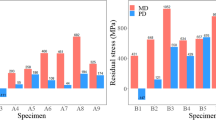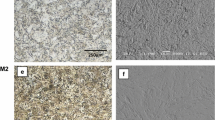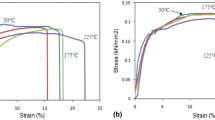Abstract
This study examined the residual stresses on the surface and in the interior of a deep-drawn cup made from a 1180-MPa class ultra-high strength steel sheet. A high residual stress causes a delayed material fracture, and an accurate evaluation of residual stress reduces failure risks. Nevertheless, the residual stress in the vicinity of the scratch marks, induced by galling in the stamping process, remains unclear. This study accordingly presented X-ray diffraction measurements of the considerable residual compressive stress associated with the scratch marks. Measurements obtained using the hole drilling method revealed a previously unknown high residual tensile stress (exceeding 1000 MPa) in the interior at the scratch mark locations, corresponding to a 0.1-mm-thick compressive zone. These measurements were then compared with the results of a finite element (FE) simulation of the deep drawing process performed without the formation of the scratch marks; the simulated residual stress in the scratch mark region considerably deviated from the measurements. A compressive stress of approximately 1000 MPa was therefore imposed on the local surface area to account for the formation of the scratch marks. The prediction of the actual residual stress on the surface and in the interior of the scratch mark region was then discussed. A simple surface stress modification technique for scratch mark prediction was realized from the comparison between the measured and FE simulation results. The stored friction work, modified by the equivalent plastic strain induced by deep drawing, could be adopted to accurately predict the location of the scratch mark region.














Similar content being viewed by others
Data availability
The authors confirm that the data supporting the findings of this study are available within the article.
References
Takagi S, Toji Y, Yoshino M, Hasegawa K (2012) Hydrogen embrittlement resistance evaluation of ultra high strength steel sheets for automobiles. ISIJ Int 52:316–322. https://doi.org/10.2355/isijinternational.52.316
Hojo T, Kobayashi J, Sugimoto K, Nagasaka A, Akiyama E (2020) Effects of alloying elements addition on delayed fracture properties of ultra high-strength TRIP-aided martensitic steels. Metals 10:6. https://doi.org/10.3390/met10010006
Lin J, Ma N, Lei Y, Murakawa H (2017) Measurement of residual stress in arc welded lap joints by cosα X-ray diffraction method. J Mater Process Technol 243:387–394. https://doi.org/10.1016/j.jmatprotec.2016.12.021
Sun J, Klassen J, Nitschke-Pagel T, Dilger K (2018) Effects of heat source geometric parameters and arc efficiency on welding temperature field, residual stress, and distortion in thin-plate full-penetration welds. Int J Adv Manuf Technol 99:497–515. https://doi.org/10.1007/s00170-018-2516-6
Nodeh IR, Serajzadeh S, Kokabi AH (2008) Simulation of welding residual stresses in resistance spot welding, FE modeling and X-ray verification. J Mater Process Technol 205:60–69. https://doi.org/10.1016/j.jmatprotec.2007.11.104
Takagi S, Toji Y, Hasegawa K, Tanaka Y, Roessler N, Hammer B, Heller T (2010) Hydrogen embrittlement evaluation methods for ultra-high strength steel sheets for automobiles. Int J Aut Eng 1:7–13. https://doi.org/10.20485/jsaeijae.1.2_7
Tan CJ, Ibrahim MS, Muhamad MR (2019) Preventing delayed cracks in SUS304 deep drawn cups using extreme blank holding forces aided by nanolubrication. Int J Adv Manuf Technol 100:1341–1354. https://doi.org/10.1007/s00170-018-2772-5
Li J, Deng L, Wang X, Jin J (2017) Research on residual stresses during hot stamping with flat and local-thickened plates. Int J Adv Manuf Technol 92:2987–2999. https://doi.org/10.1007/s00170-017-0386-y
Mori K, Abe Y, Murai Y (2020) Prevention of delayed cracking of punched 1.5 GPa ultra-high strength steel sheets by ironing with punched slug. Int J Adv Manuf Technol 109:2503–2510. https://doi.org/10.1007/s00170-020-05786-w
Matsuno T, Sekito Y, Sakurada E, Suzuki T, Kawasaki K, Suehiro M (2014) Resistance of hydrogen embrittlement on hot-sheared surface during die-quench process. ISIJ Int 54:2369–2374. https://doi.org/10.2355/isijinternational.54.2369
Hojo T, Akiyama E, Saitoh H, Shiro A, Yasuda R, Shobu T, Kinugasa J, Yuse F (2020) Effects of residual stress and plastic strain on hydrogen embrittlement of a stretch-formed TRIP-aided martensitic steel sheet. Corros Sci 177:108957. https://doi.org/10.1016/j.corsci.2020.108957
Matsuno T, Sakurada E, Seto A (2016) Fatigue strength of high-strength steel sheets after tension-compression and surface friction. J Jpn Soc Technol Plast 7:660–666. (in Japanese). https://doi.org/10.9773/sosei.57.660
Zhao C, Li J, Fan W, Liu Y, Wang W (2020) Experimental and simulation research on residual stress for abrasive belt rail grinding. Int J Adv Manuf Technol 109:129–142. https://doi.org/10.1007/s00170-020-05664-5
Shen S, Li B, Guo W (2020) Experimental study on grinding-induced residual stress in C-250 maraging steel. Int J Adv Manuf Technol 106:953–967. https://doi.org/10.1007/s00170-019-04655-5
Berrahmoune MR, Berveiller S, Inal K, Patoor E (2006) Delayed cracking in 301LN austenitic steel after deep drawing: martensitic transformation and residual stress analysis. Mater Sci Eng A 438-440:262–266. https://doi.org/10.1016/j.msea.2006.02.189
Papula S, Saukkonen T, Talonen J, Hänninen H (2015) Delayed cracking of metastable austenitic stainless steels after deep drawing. ISIJ Int 55:2182–2188. https://doi.org/10.2355/isijinternational.ISIJINT-2015-078
Abe Y, Ohmi T, Mori K, Masuda T (2014) Improvement of formability in deep drawing of ultra-high strength steel sheets by coating of die. J Mater Process Technol 214:1838–1843. https://doi.org/10.1016/j.jmatprotec.2014.03.023
Yao C, Zhang J, Cui M, Tan L, Shen X (2020) Machining deformation prediction of large fan blades based on loading uneven residual stress. Int J Adv Manuf Technol 107:4345–4356. https://doi.org/10.1007/s00170-020-05316-8
Toparli MB, Fitzpatrick ME, Gungor S (2015) Determination of multiple near-surface residual stress components in laser peened aluminum alloy via the contour method. Metall Mater Trans A 46:4268–4275. https://doi.org/10.1007/s11661-015-3026-x
Levieil B, Bridier F, Doudard C, Thevenet D, Calloch S (2016) User influence on two complementary residual stress determination methods: contour method and incremental X-ray diffraction. Exp Mech 56:1641–1652. https://doi.org/10.1007/s11340-016-0189-3
ASTM E837 - 20 (2020) Standard test method for determining residual stresses by the hole-drilling strain-gage method. ASTM Int, West Conshohocken. https://doi.org/10.1520/E0837-20
Shukla S (2020) Rapid in-line residual stress analysis from a portable two-dimensional X-ray diffractometer. Measurement 157:107672. https://doi.org/10.1016/j.measurement.2020.107672
Maruyama Y, Miyazaki T, Sasaki T (2015) Development and validation of an X-Ray stress measurement device using an image plate suitable for the cosα method. J Soc Mater Sci Jpn 64:560–566. (in Japanese). https://doi.org/10.2472/jsms.64.560
Tanaka K (2019) The cosα method for X-ray residual stress measurement using two-dimensional detector. Mech Eng Rev 6:18–00378. https://doi.org/10.1299/mer.18-00378
Schajer GS (1988) Measurement of non-uniform residual stresses using the hole-drilling method. Part I—stress calculation procedures. J Eng Mater Technol 110:338–343. https://doi.org/10.1115/1.3226059
Hajbarati H, Zajkani A (2020) A novel finite element simulation of hot stamping process of DP780 steel based on the Chaboche thermomechanically hardening model. Int J Adv Manuf Technol 111:2705–2718. https://doi.org/10.1007/s00170-020-06297-4
Barabash AV, Gavril’chenko EY, Gribkov EP, Markov OE (2014) Straightening of sheet with correction of waviness. Steel in translation 44:916–920
Matsuno T, Seto A, Suehiro M, Kuriyama Y Murakami H (2012) FEM analysis of high strength steel sheets up to fracture and its application to piercing process. In: Proc. IDDRG2012 Mumbai: 134-140
Kim JG, Yoon J, Baek SM, Seo MH, Cho WT, Chin KG, Chin K-G, Lee S, Kim HS (2017) Residual stress effect on the delayed fracture of twinning-induced plasticity steels. Metall Mater Trans A 48:2692–2696. https://doi.org/10.1007/s11661-017-4056-3
Luo ZC, Liu RD, Wang X, Yen HW, Huang MX (2019) The role of plastic strain on the delayed fracture behavior of twinning-induced plasticity steels. Metall Mater Trans A 50:1437–1447. https://doi.org/10.1007/s11661-018-5087-0
Pelcastre L, Hardell J, Prakash B (2013) Galling mechanisms during interaction of tool steel and Al–Si coated ultra-high strength steel at elevated temperature. Tribol Int 67:263–271 https://doi.org/10.1016/j.triboint.2013.08.007
Dong W, Xu L, Lin Q, Wang Z (2017) Experimental and numerical investigation on galling behavior in sheet metal forming process. Int J Adv Manuf Technol 88:1101–1109. https://doi.org/10.1007/s00170-020-06297-4
Khruschov MM (1974) Principles of abrasive wear. Wear 28:69–88. https://doi.org/10.1016/0043-1648(74)90102-1
Author information
Authors and Affiliations
Contributions
Takashi Matsuno: simulation, validation, formal analysis, writing–original draft. Yuta Ochiai: XRD measurement, visualization. Yoshitaka Okitsu: material, conceptualization, resources, supervision of research. Masayuki Iga: material, supervision of research. Ami Kohri: HDM measurement. Takao Mikami: HDM measurement.
Corresponding author
Ethics declarations
Conflict of interest
The authors declare no competing interests.
Additional information
Publisher’s note
Springer Nature remains neutral with regard to jurisdictional claims in published maps and institutional affiliations.
Rights and permissions
About this article
Cite this article
Matsuno, T., Ochiai, Y., Okitsu, Y. et al. Surface and interior residual stress analysis of a deep-drawn 1180-MPa class ultra-high strength steel sheet with scratch marks. Int J Adv Manuf Technol 116, 2873–2884 (2021). https://doi.org/10.1007/s00170-021-07675-2
Received:
Accepted:
Published:
Issue Date:
DOI: https://doi.org/10.1007/s00170-021-07675-2




